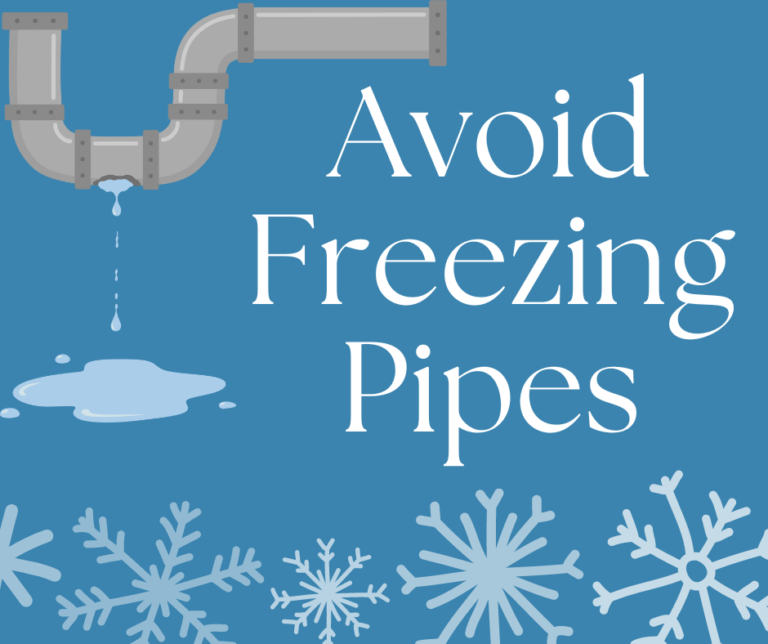Winter brings a picturesque landscape of snow-covered streets and cozy nights by the fireplace. However, it also brings the risk of frozen pipes, a common and potentially costly problem for homeowners. Frozen pipes can lead to burst pipes and water damage, causing headaches and hefty repair bills. In this comprehensive guide, we will delve deeper into effective strategies to avoid freezing pipes and safeguard your home during the colder months.
Insulate Exposed Pipes:
While the importance of insulating exposed pipes cannot be overstated, it’s essential to choose the right insulation materials. Foam sleeves and pipe wraps are widely available and can be easily installed.
Pay special attention to pipes in unheated areas like basements, attics, and crawl spaces. This extra layer of insulation acts as a barrier, preventing the cold from penetrating and affecting the water inside.
Seal Gaps and Cracks:
The process of sealing gaps and cracks in your home is not only beneficial for preventing frozen pipes but also for overall energy efficiency. Use caulk or weatherstripping to seal gaps in windows, doors, and walls.
By creating a draft-free environment, you minimize the chances of cold air infiltrating your home and putting your pipes at risk.
Maintain Adequate Heating:
A consistent and adequate heating system is paramount in safeguarding your pipes during winter. Check that your heating system is in good working order before the cold sets in.
Insulate rooms with exposed pipes and keep the thermostat set to a temperature that ensures your home remains warm, even when you’re away.
Allow Faucets to Drip:
The concept of letting faucets drip slightly during extremely cold weather is based on the principle that moving water is less likely to freeze. This can be particularly useful for pipes along exterior walls.
It’s a small, continuous flow that helps prevent pressure build-up and reduces the risk of freezing.
Disconnect and Drain Outdoor Hoses:
Outdoor hoses left connected can cause water to freeze inside, leading to potential damage not only to the hose but also to the connected faucet and pipes.
Before the onset of winter, disconnect hoses, drain any residual water, and store them in a sheltered place. This simple step can save you from unnecessary headaches come spring.
Use Pipe Heating Cables:
For those living in regions with extremely harsh winter conditions, investing in pipe heating cables is a proactive approach.
These cables wrap around pipes and provide a consistent source of heat, preventing them from reaching freezing temperatures. They are particularly beneficial for pipes in hard-to-reach or exposed areas.
Open Cabinet Doors:
In colder areas of your home, such as under sinks, opening cabinet doors allows warm air to circulate around pipes, helping to maintain a higher temperature.
This is especially relevant in kitchens and bathrooms where pipes are often located against exterior walls.
Be Mindful of Thermostat Settings:
Setting your thermostat too low, especially when away, can increase the risk of frozen pipes. Consider keeping your thermostat at a slightly higher temperature during winter months, even when the house is unoccupied.
Investing in a programmable thermostat allows for efficient temperature regulation.
Perform Regular Inspections:
Regular inspections of your plumbing system are crucial for identifying potential issues before they escalate. Look for signs of leaks, dampness, or unusual odors.
Addressing problems promptly can prevent frozen pipes and minimize the risk of more extensive damage.
FAQ:
Q1: What should I do if my pipes freeze?
A: Turn off the water supply, open faucets to relieve pressure, and use a hairdryer or heating pad to thaw the pipes gently.
Q2: Can I use hot water to thaw frozen pipes?
A: It’s not recommended, as sudden temperature changes can lead to pipe damage. Use lukewarm water or a heating source with caution.
Q3: How can I prevent outdoor pipes from freezing?
A: Insulate outdoor pipes, disconnect hoses, and consider installing insulated covers on outdoor faucets.
Q4: Should I keep all faucets dripping during cold weather?
A: It’s not necessary for every faucet. Focus on faucets connected to vulnerable pipes in unheated areas.
Conclusion:
Protecting your pipes from freezing is a multifaceted task that involves insulation, maintenance, and proactive measures. By implementing these strategies and staying vigilant, you can significantly reduce the risk of frozen pipes and the subsequent damage they may cause. Regular inspections, proper insulation, and mindful thermostat settings contribute to a resilient plumbing system, ensuring your home stays warm and dry during the winter months.

A group of home improvement enthusiasts and bathroom design experts, combines in-depth knowledge and a shared passion to deliver engaging, informative content that guides readers through the world of bathroom innovation and style.

Leave a Reply